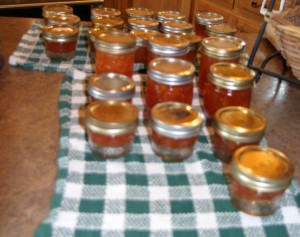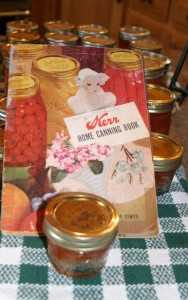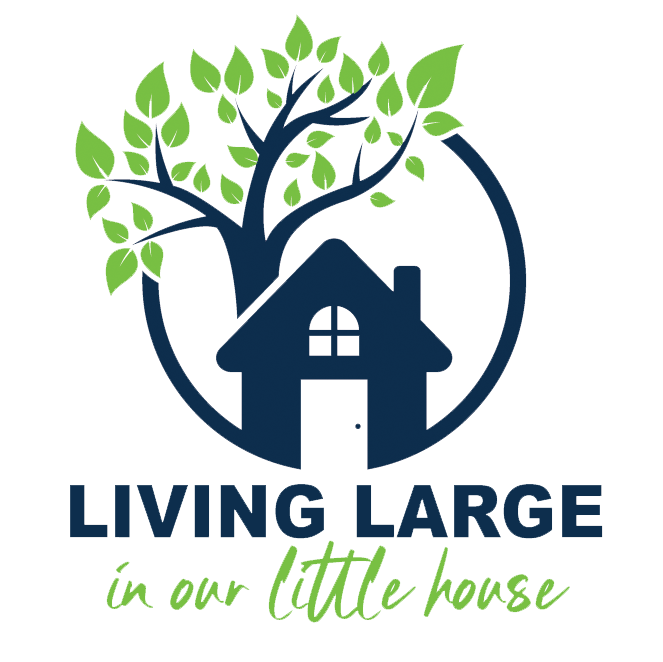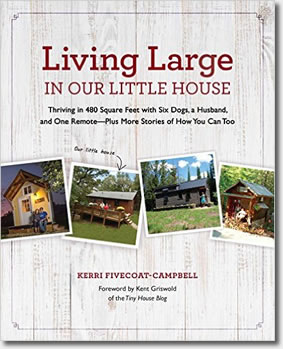I Can Can!
The mysteries of canning have finally been revealed to me.
As I’ve written before, I’ve wanted to learn to can since even before we moved to Our Little House. I had written a story several years ago on an older woman, her garden and her canning and although she invited me back for lessons, I never took the time.
When we moved here, I knew I wanted to learn and this year, I even included a bunch of canned jars of fruit on my vision board.
I asked our friends who are sharing their garden space with us if they can. “Oh, no,” Alicia told me. “I freeze everything, canning is just so much work.”
Rae, our end of the point neighbor, told me she would teach me if I supplied tomatoes from our garden.
This week, however, she supplied a bushel of peaches of which we made peach jam. On the first day, we made sugar laced jam, on the second day it was sugar free.
Here are some things I learned about canning this week:
- It is hot and hard work. Boiling and sanitizing all of the instruments and jars. Blanching fruit and “bathing” the finished jars.
- My hands literally got waterlogged from peeling and cutting up the juicy fruit. By the time I was finished, my elbows were sticking to the counter.
- I can see why my friend was so eager to teach me the art of canning. Doing it by yourself wouldn’t be half as much fun and really, nearly impossible to keep up with all the steps.
- Comparing canning books from 1948-present was really fun. We learned the earlier books were less technical (afterall, we think the books assumed people knew this stuff) and contained a lot less sugar than today’s recipes.
We had a good time and we do plan to can some tomatoes, sauce and salsa if we get enough bounty from the garden. However, I am going to also look into freezing. Some of those books have freezing methods as well.
How about you – freezing or canning fresh fruits and veggies from the garden?










This is a project on my list to learn. I finally accomplished bread making and canning is next. I’ve been a little afraid of it as I didn’t want to do it wrong and poison the family. The different comments on this post is encouraging me on especially if I don’t have to use a pressure cooker! Congratulations on learning how!
Good to hear from you shebear! I was afraid of doing it wrong and poisoning my husband too. Just do it the first time with a seasoned canner and you really can’t go wrong!
Hi Kerri, I love to can too! Every year I grow tons of tomatoes so that I can have enough canned tomatoes to carry me through winter. Tomatoes are very easy to can, because of the high acidity level you do not have to pressure cook at all. You can make salsa or even just cut the tomato to pieces and squash into sterilized jars, then cook in water bath for 45 minutes. This is very common in the south of Italy and is called “pommodori a pezzi”. It produces a tomato as close to the fresh tomato as is possible and is a great base for sauces. I also make “pelati”, which are peeled tomatoes (just dunk in boiling water for a few seconds and the skins will slip off easily, then put in jars to can). The best, though is when we fire the wood oven for pizza and I manage to roast a huge tray of ripe tomatoes that are then canned. This produces a smoky, very sweet tomato base perfect for special sauces.
One thing I like to do is just can a little at a time so as to not make a huge production out of it. Every time I get enough extra tomatoes or veggies, I can a few jars. By the end of summer I have my winter store ready!
That sounds yummy, Vida, thanks for sharing!
Kerri, with modern pressure canners there is a high degree of safety built in. They open an entire world of safe food canning–things that you could not do with a water bath method like meat dishes, for example. Home made chili can be spectacular, and making extra when you cook it to put by some that will last for months with no worry of power outages means there is really very little additional work to be done. In addition, the pressure canners can be used for preparing many foods as quickly as a microwave can, while preserving color, flavor, and texture. They are great for making large quantities of food for picnics, reunions, and parties to give just one example. In a pressure cooker, too, you can make bean dishes quickly without the long soaking beforehand–very convenient and a cheap way to eat as well. There are some very good pressure cooking cookbooks, too, that will give you the low-down. So take a look at the best brands–they are very safe and easy to use these days.
I will do that, David, thank you for sharing!
I just started canning this year, and I LOVE it! My husband’s mom has canned for years and years, and when I first met him, I thought it was kind of strange. But after learning more about commercial food, I became more interested in doing it. So far this year I’ve made vanilla strawberry jam, blueberry jam, peach jam, blackberry jam, and hot salsa. I find it really easy and surprisingly fun! We don’t have a garden yet but plan to plant one next year–and I’m looking forward to preserving all those goodies.
It is work, though. But it’s worth it.
Good for you, Cate! It sounds like you have a wonderful array of fruits. Loved canned salsa.
I suspect more people will get into canning given the increasingly depressing and worrying news about BPA levels in tinned foods. I know I’m planning to give it a go this year.
Yes, that is just one more thing to worry about. It’s really frustrating anymore.
I think canning is hard work! I remember helping my Grandma. Days of snapping beans, blanching corn, etc. but they sure looked pretty afterward in her pantry. I canned hot banana pepper rings last year, very easy. Canned pickled okra is really easy. So I say stick to easy ones like pickles, okra. Freeze the corn and peas. One thing to stay away from are recipes that require a lot of prep work(like relish). I now know why Grandma was also frantic when the garden starting “coming in”…all the work that laid ahead..whew! Getting help in the kitchen on canning day was a must!
The prep work is really the hardest part of it, Sandy. But I also know what my aunt is talking about when everything starts coming on. She cans a lot as well.
Reasons to can it taste good and looks pretty on the shelf. I use to do a lot with my mother and later, when I had a yard filled with fruit trees in Oregon. Kerri, your photos are enticing, just like the magazines.
Thanks, Mary! 🙂
I’m interested to see folks reporting that the sugar free jams and preserves are harder to get right; anyone know why? I love the pure fruit store preserves and would like to learn to make them on my own.
For us, Melanie, I think it was getting the sweetner exactly right. We didn’t want it too sweet and the recipes seemed to make everything tooth-hurting sweet.
I love canning! I’ve been doing it for years for jams and conserves, even before I knew how to do regular cooking. It really doesn’t need to be a complicated process. Doing some vegetables can require a pressure canner, but fruits with sugar (jams, jellies, whole in syrup) are ridiculously easy. In fact, the rules come down to these:
1) Boil everyting (jars, lids, tongs, funnel, etc.) so they’re sterile. OR run them through the hot cycle of your dishwasher – it’s just as effective and a lot less hassle.
2) Make your hot stuff (jam, jelly, fruit in syrup)
3) Fill jars with hot stuff to the bottom of the jar threads (not higher or lower)
4) Boil the jars for 10 minutes (covered by an inch of water). Let them cool on the counter overnight and refrigerate any that didn’t seal (but I’ve never had a seal fail).
That’s really all there is to it. The jam/jelly/whatever is something you were going to make anyway. Putting it into a hot jar and boiling the jar isn’t any extra work. 🙂
That’s about what it “boils” down to! 😉 Thanks for posting, Friday!
Congratulations!
I canned strawberry jam for the first time this year and LOVED it. (My sugarless recipe is a little loose and funky, but the sugar recipes turned out just awesome.)
Peach jam would be amazing, I’m sure. I’ll have to try that– I’ve been freezing bags of sliced peaches, but a few jars of peach jam might brighten up the winter nicely.
Our wal-mart gets a lot of canning materials in every spring, but once they sell out, that’s it. They have some jars year round, I think, but not many different kinds. I check a local junk shop for jars- they sell them for 25 cents each, and I’ve collected a nice array of unusual antique ones that way (they’re still good for using as long as there are no chips or cracks). I saw a picture once of an Amish family’s canning collection- some of their jars were nearly 100 years old and passed down from generation to generation. I love that idea and wish I’d snagged some of my grandmother’s when she passed away.
I would have loved to have had some of my grandmother’s also, Kim! Our sugar free ones look a little funky too. We’ll see.
I’ve never actually tried canning because I grew up hearing about people getting sick if the food wasn’t canned right, maybe it was my mother’s way of avoiding the work. I would like to try it though. I usually freeze items or dehydrate them. We tend to lose our power so I wouldn’t really want too much in the freezer. I’ve been trying to learn new things to help when we are able to move to the country so maybe I’ll try canning this year. Thanks for inspiring me : )
You can get sick if it isn’t canned right, Mary, but hopefully ours was. We sat there listening to some of the jars “sealing” (popping), so I think we’re good! 🙂
We don’t have a big freezer, but we lose power often too and we had to get a generator. Good luck with your canning. As V suggests, find someone who has been doing it awhile and offer to help in return for the lessons. Believe me, I don’t think they will mind!
Alexandra,
Do you have a hardware store close or a general store? If so, you can find your supplies there. There is also a website called Lehmans.(www.lehmans.com) they carry supplies, search for canning, or canning supplies and you will come up with a lot. I have old fashioned hardware stores here where I live in Nebraska, and farm supply stores, so I get my jars there. I went to GoodWill last week and got 40 jars there also, Yippeeeeeee
There is another website that is the first to really make a statement in the urban homestead movement, it is http://www.pathtofreedom.com, and they can food, are are totally not dependent on things, and they live right in the middle of urban Pasedena CA. They are lovely people and you will delight in the website’s blog. They can also.
I waterbath can, I don’t do pressure canner, as I am very afraid of it, I put one of those into the Jr High’s ceiling during Home Ec. one time. it is work, but I can 75% of my family’s food to control the chemicals and content of food and sugar, and do a little freezing also. I also dehydrate a lot of food also, including veg. and herbs and tomatoes and sauce.
I just started pickles, my tomatoes are very slow, I am drying herbs and making pesto, and a few peppers.
It is totally worth it, I control most of what goes into my family’s food, you cannot trust anything anymore, or anyone telling you “its ok to eat” after its been sprayed with poison. That does not float my boat. I also purchase vegetables from my farmer’s market that I sell at from the other vendors, things I cannot grow or don’t grow from them. I have been drying leeks for winter and this have turned out just great.
For me, it is the high point of providing for the family and home and part of the job of living more self suffient lives on our part. But like we were talking last week, it takes baby steps and you just have to commit time to do this. Also start out small and if you can find a buddy, older woman who has canned, like Kerri did, go for it. Don’t turn the chance down, you will be sorry for not doing it.
You’re inspiring to our community, V! Thanks for all the great tips! One of the recipes we found in one of Rae’s numerous books called for a pressure cooker and both of us were scared of it too. My mother in law uses a pressure cooker for certain dishes, but I don’t like them either.
One of the things I look forward to when we move to the country, is canning fruits and vegetables from our garden. Though I “helped” my grandmother with canning as a kid growing up, I’ve long since forgotten the steps involved. I might be turning to you for advice, Kerri! We have also purchased a large freezer from the woman we’re buying property from, so between canning and freezing, I am hoping that in the future, most of our food will come from our own efforts and will be chemical-free. I also plan to have chickens, so will have fresh eggs too. However, I am not willing to milk a cow every day,(and also don’t like the smell!) so dairy products will still have to be bought from the store. My brother-in- law raises black angus cattle. It would be possible to go in together with someone on buying a grass fed cow, and split the meat when it is butchered. Unfortunately, I’m not sure I could eat a cow that I “know.” Even if its name is just No.B67, it’s a little too personal to actually put a face to my hamburger. Besides, we really don’t eat a lot of meat anyway. At any rate, I am excited about changing not only our lifestyle, but the way we eat too, to a more healthy, organic diet.
Looking forward to your stories about your new life, Kathleen. I know you’re going to love it!
I even hate to say this, Alexandra, but we’ve seen them at Wal-Mart (our only store in town, as well as the farm and home. If you watch yard and estate sales, you can also pick them up. My friend had boxes and boxes and Alicia gave us more. Ask around, I’m sure you can find some used ones!
I want to learn canning, too. Love the title of this post! Where do I buy the jars??
Hi Alexandra- You could check out your local freecycle group for canning supplies, mine has them all the time.